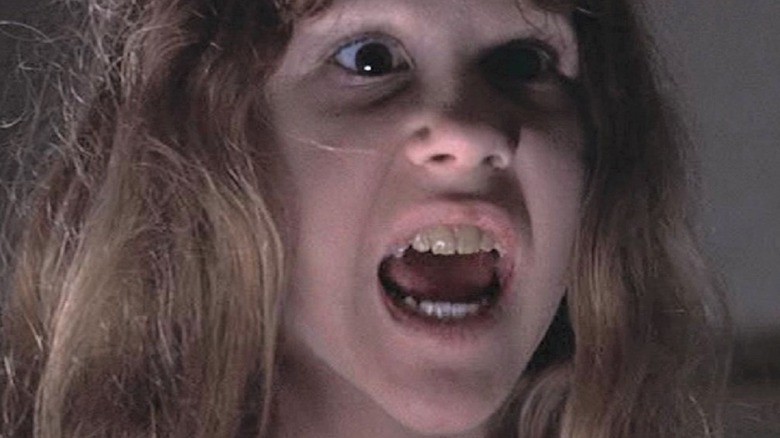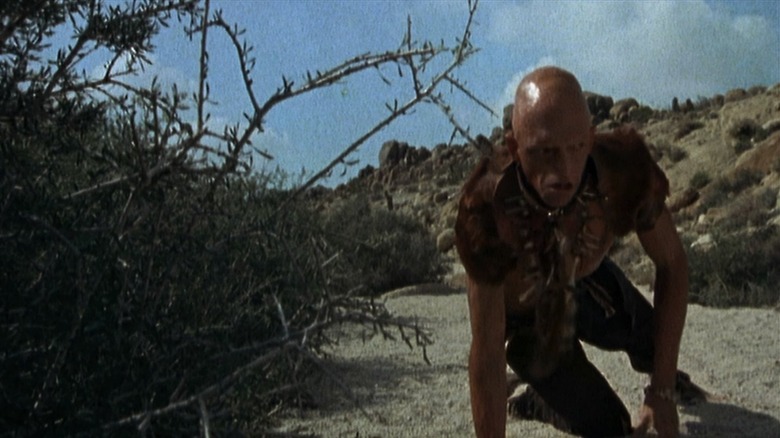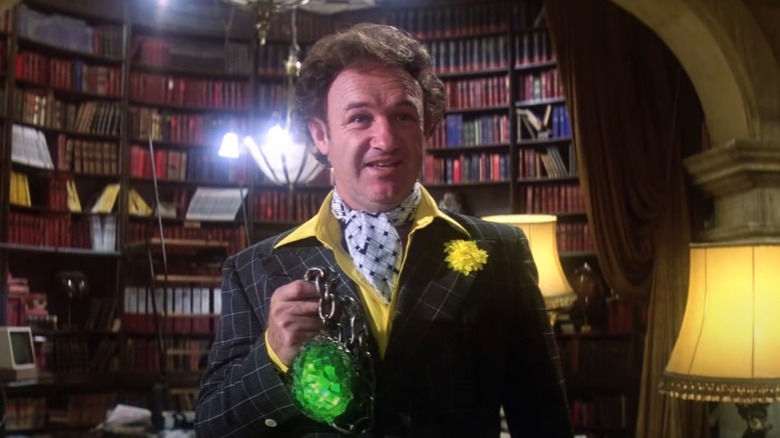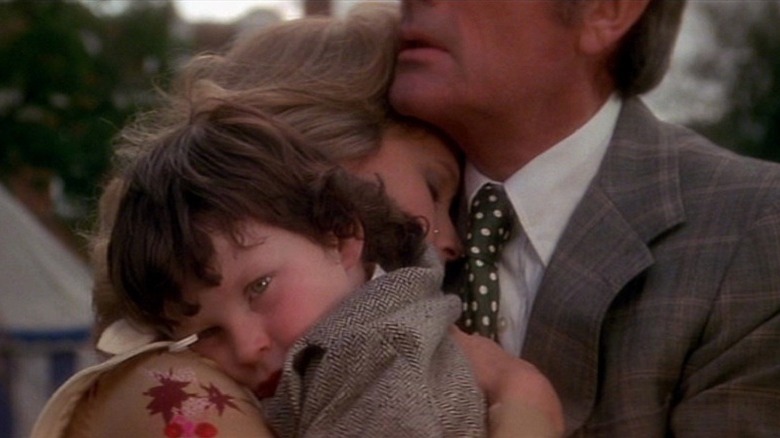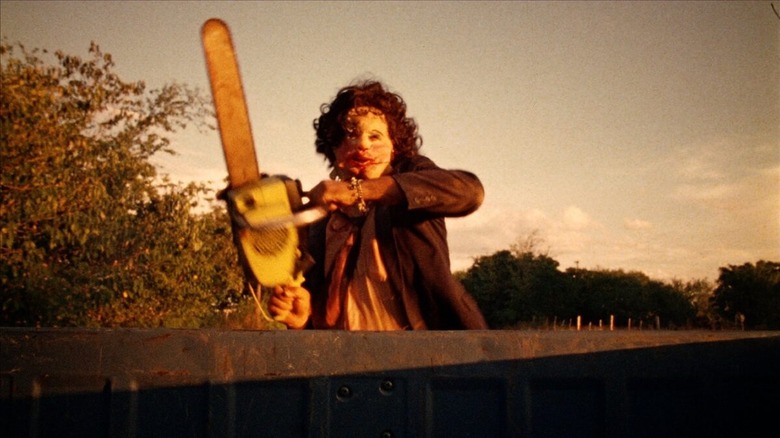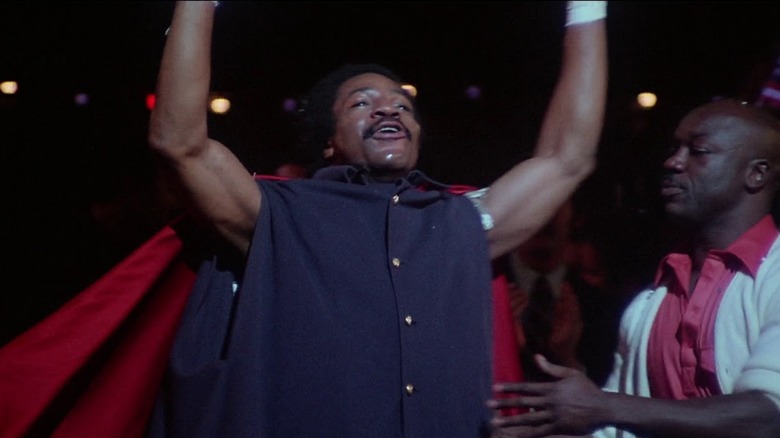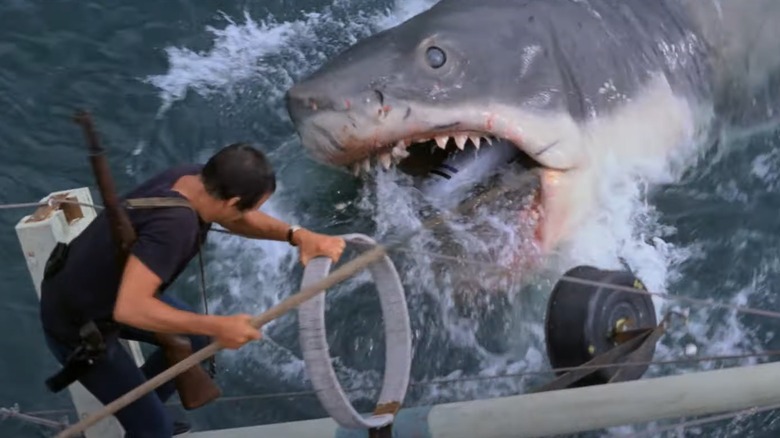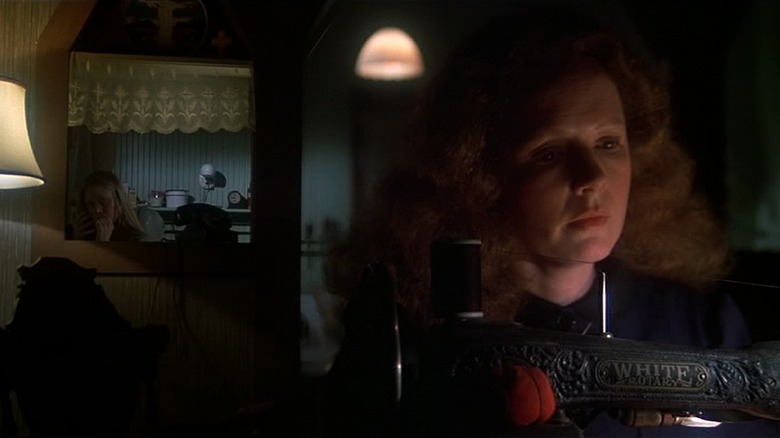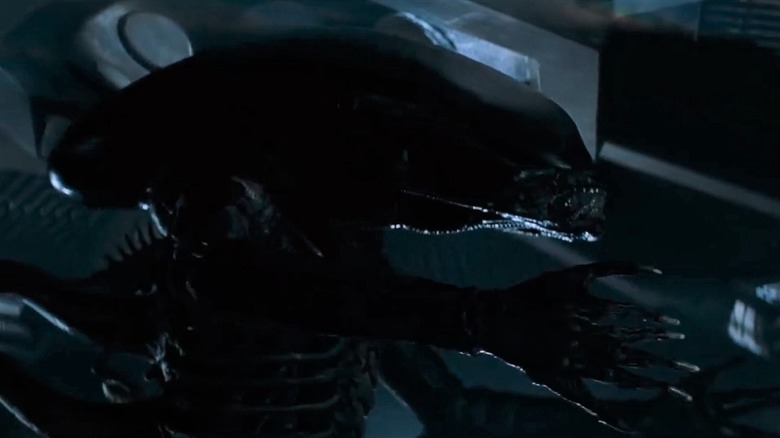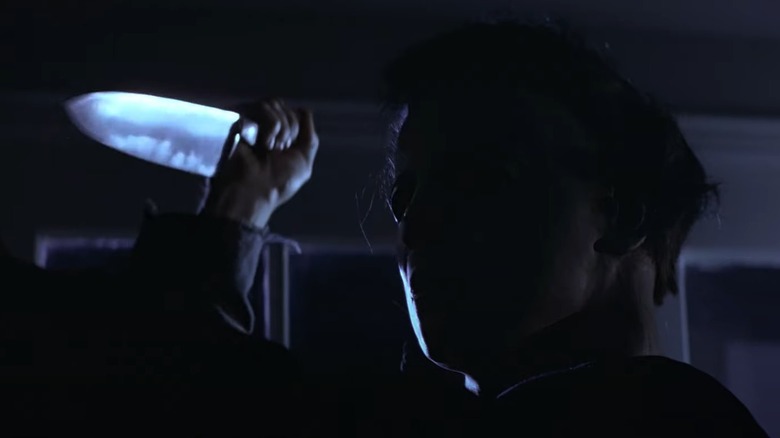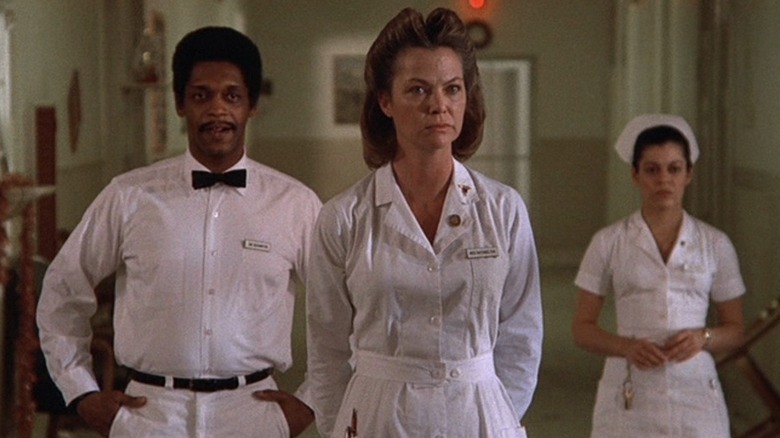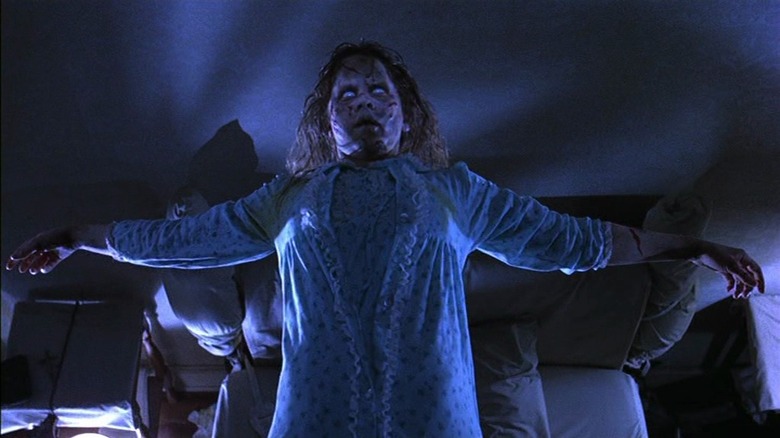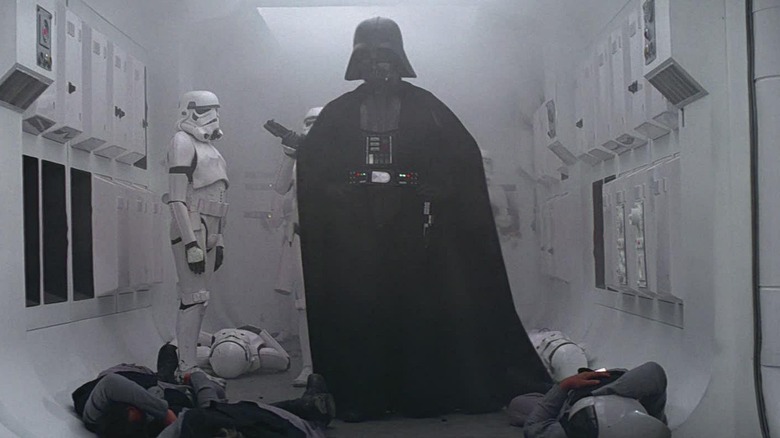Best Movie Villains Of The 1970s
What's a hero without a villain to challenge them? Pretty boring, that's what. Luckily for anyone who loves to hate a great bad guy, movies in the 1970s were filled to bursting with some all-time classic crooks, creeps, mutants, and schemers. Seriously, the decade featured killer creatures (both from Earth and beyond), knife-wielding murderers, demonic forces, and dark wizards from space. The best of the worst are the ones we love to hate, the ones we root against, and the ones who push our heroes to the limits, forcing them to change for the better in order to save the day.
So which '70s movie bad guys are the most diabolical and despicable of all time? Well, we've assembled a decidedly non-exhaustive list here, complete with all sorts of terrifying rogues. (Note: To qualify, it must be a character first introduced in a movie released between January 1, 1970 and December 31, 1979.) These are the greatest movie villains of the 1970s.
Warning: Major spoilers ahead!
The mutants from The Hills Have Eyes
What's the worst thing that pops into your head when your car breaks down in the middle of nowhere? Dead cell phone? No one will find you? Starvation? If you've seen Wes Craven's "The Hills Have Eyes," you're likely imagining something even more terrifying — being attacked by murderous, inbred, mutant cannibals who live in the nearby hills.
Led by the hulking, violent Papa Jupiter, the mutants — Mars, Pluto, Mercury, Mama, and Ruby — survive by feasting on any foolish travelers who wander too close to their home in the titular hills. That's an unfortunate reality for the poor Carter family. After unwisely ignoring the advice they get from the obligatory gas station attendant, who warned them about straying from the main road, their camper breaks down in the worst imaginable spot.
They then fall into the clutches of the cannibals, who raid their camp, murder a few folks, commit unspeakable acts on others, kill the dogs, and even kidnap a baby. But the story's not finished — the surviving Carters get a chance for some serious vengeance, and it's one of the most satisfying revenge sequences ever shot. In fact, the mutant family is so much fun to hate that it makes them a shoo-in for this list.
Lex Luthor from Superman
Superhero movies might not have really taken off until the late '80s and '90s (or really explode until the 2000s), but in the 1970s, we were treated to one of the best. Released in 1978, "Superman," starring Christopher Reeve as the Man of Steel, is an all-time classic. Just check out the Rotten Tomatoes critics consensus on the too-often slept-on comic book flick: "'Superman' deftly blends humor and gravitas, taking advantage of the perfectly cast Christopher Reeve to craft a loving, nostalgic tribute to an American pop culture icon."
The story covers a lot of ground, from Superman's alien origins to his upbringing in Smallville to his donning the cape and tights and finally facing off against his arch-enemy: Lex Luthor (Gene Hackman). In the movie, Superman's chief rival hatches one of the most famously brainless bad guy plots of all time: He wants to nuke the U.S. Pacific coast in order to turn his Nevada real estate into valuable beachfront property. "Stupid" doesn't begin to describe the "thinking" at work here, but that's part of the fun. Hackman makes a delightful meal out of his performance — hamming it up in the most perfect way while also bringing some understated menace — and is one of the foremost reasons the movie still holds up so well.
Damien Thorn from The Omen
A possessed Regan MacNeil is the quintessential terrifying, devil-infested fictional child. But don't sleep on Damien Thorn, the '70s other majorly creepy kid. We mean that — don't ever close your eyes around him or, honestly, spend much time near him at all. As we learn throughout the movie, the fearsome boy from "The Omen" (Harvey Spencer Stephens) — replaced at birth by his father without his mother's knowledge after their actual biological son dies at birth — is actually the Antichrist. Bad luck for the Thorn family.
To be fair to Damien, he doesn't seem to directly cause the killer Rottweiler to appear in the family home, his nanny to hang herself, the freakishly violent death of the priest who warns his father (Gregory Peck) that his adopted son is the actually the offspring of Satan himself, or the rest of the violent mayhem that engulfs the family. But given that demonic, ice-cold stare — all the more unnerving due to his age — he doesn't seem to mind it either. In fact, the son of the devil, appropriately enough, seems to enjoy it all.
The very serious tone of the film, centered around checking off Biblical end-times prophecies and placing Beelzebub Jr. in the middle of them, might be of little interest to some viewers. But Damien himself will never stop haunting you.
Leatherface from The Texas Chain Saw Massacre
A full three years before "Halloween" gave us Michael Myers and the slasher film blueprint, there was 1974's "The Texas Chain Saw Massacre." If you've never seen the movie, you might be surprised at how bloodless it actually is, given its name and reputation within the horror community at large. But the lack of gore doesn't in any way subtract from the film's enduring ability to terrify all these years later.
It's about a group of young, road-tripping friends (essentially a dinner bell for bad guys right there) who end up in the clutches of a family of cannibalistic yokels while driving through rural Texas. Therefore, Leatherface himself isn't alone. And he's not even the patriarch here. He's just a hulking, apron-wearing, chainsaw-wielding, mentally disabled man who does most of the family's butchering (but not necessarily its kidnapping or tormenting). His limited mental capacity and the fact that, presumably, he's spent his whole life isolated in the murder house with his family makes it unlikely he understands that what he's doing is wrong. It's just what he knows, and that makes him sad and unforgettable, as well as terrifying.
Leatherface, of course, gets his name from the mask he wears, made of the skin of his victims (loosely based on real-life killer Ed Gein). The shot of him in the road after the final victim escapes, dancing with his roaring chainsaw, ranks among the most iconic and frightening images in all of horror.
Apollo Creed in Rocky
Like most of the other movies on this list, you've almost definitely seen "Rocky" before. The landmark 1976 sports drama – a Best Picture winner at the Academy Awards — is a rags-to-riches story that follows the titular Rocky Balboa (Sylvester Stallone in his breakout role), a down-on-his-luck loan shark enforcer in Philadelphia who trains to box after getting a shot at the heavyweight championship.
It's won't be easy, of course. The champ he must dethrone is Apollo Creed (Carl Weathers) — a dominating force in the ring, as any title defender in his prime should be. The fight scene the movie is building towards all along ends with a pyrrhic Creed victory. But Balboa makes him work for it, going the distance without being KO'd and landing plenty of hooks and uppercuts on his boastful opponent in the process. In the end, Creed raises Rocky's arm — a sign the titular underdog has earned his respect. It's a predictable sports movie cliche, but only because you've seen it in plenty of other movies that were themselves inspired by "Rocky." And this film earns the moment.
Creed makes appearances in the "Rocky" sequels, both as Balboa's opponent and friend. But everything you need to know about the trash-talking boxing legend can be found in the original sports drama masterpiece.
The shark in Jaws
"You know the thing about a shark — he's got ... lifeless eyes, black eyes, like a doll's eye. When he comes at ya, doesn't seem to be living. Until he bites ya, and those black eyes roll over white. And then, ah then, you hear that terrible high-pitch screaming, and the ocean turns red."
So says Quint (Robert Shaw), who was hired to hunt down a killer shark that's been terrorizing Amity Island. Chief Martin Brody (Roy Scheider) and marine biologist Matt Hooper (Richard Dreyfuss) — who are accompanying Quint on his rickety boat (it might not be big enough) to see that the job is done — listen silently. Quint clearly has experience with murderous sharks. According to him, he was on the U.S.S. Indianapolis, which was torpedoed by the Japanese after delivering the atomic bomb. Its crew was then ripped to pieces by sharks until rescue could arrive. If anyone knows how to survive out here, pursued by one of nature's finest killing machines, it would be him.
But you've seen the movie. You know Quint didn't, actually, have what it takes to bring down Bruce (yes, it has a name), the monster great white at the heart of Hollywood's first true blockbuster. "Jaws" is a landmark release in cinematic history. The music, pacing, acting, and writing are perfect. But none of it would've worked if they hadn't nailed the shark itself. To our enduring delight and horror, they did.
Margaret White in Carrie
It's hard to determine who the worst bad guy is in 1976's "Carrie" (based, of course, on the Stephen King novel of the same name). The high school bullies who torment the 16-year-old title character (Sissy Spacek) are certainly in the running. They mock her when she gets her first period in the gym shower and panics (puberty never came up during her sheltered upbringing), and they infamously dump a bucket of pig blood on her after making her prom queen as part of a "prank." Carrie herself is a sympathetic character, of course, but her resulting murderous rampage makes her a contender as well. It's hard to side with someone who uses supernatural powers to burn the place down, with half the school inside it.
But the nod has to go to Carrie's fanatically religious and abusive mother, Margaret White. Played chillingly by Piper Laurie (who, along with Spacek, was nominated for an Academy Award for her performance), Margaret believes just about everything to be sinful. This is doubly true for things that involve anatomy or sex, which explains why her daughter is so sheltered and ill-equipped for adulthood. She also thinks her daughter's telekinetic powers make her a witch. You can probably guess, based on actual historical events involving violent puritans and those they suspect as being witches, how she feels about that. Laurie's performance here will chill you to the bone.
The Xenomorph from Alien
"Alien" isn't just a great film; it's a perfect one. In addition to the visuals, tone, and acting — particularly Sigourney Weaver's Ellen Ripley — Roger Ebert says the pacing is perfect. Imagine what its legacy would be if it had followed the template of the slasher films it helped inspire — diving straight into the mayhem within the first 30 minutes and killing off characters at scheduled intervals because it's afraid of losing your attention. What a waste that would've been.
No, this film likes to play with its food. It makes you wait and wait and wait some more for things to get truly interesting. But it puts every moment to good use, and you're happy for it to take its time. Why? Because deep down, even if you love the film, you don't want to be stuck in the claustrophobic corridors of the Nostromo with the titular extraterrestrial killing machine.
After all, the movie likes to keep you guessing as to the Xenomorph's nature, appearance, and capabilities. It starts off as a face-hugging spider-monster before popping out of John Hurt's chest as a worm-like parasite. Then, each time we see it, it's grown a foot and has acquired new ways of slaughtering its victims. One of its favorite techniques is simple stealth. The real terror here is the shadows. Any one of them could be housing the beast, and one of them certainly is. Whenever you figure out which, it's far too late.
Michael Myers from Halloween
Say what you will about slasher movies, but "Halloween," John Carpenter's 1978 horror film, is a landmark for the genre. The movie follows Michael Myers, a masked, knife-wielding murderer who escapes from the asylum he's been housed in since murdering his older sister when he was only 6. Pursued by his psychiatrist, Myers returns to his home town for a new killing spree on Halloween night. If it sounds like something you've seen a million times before, it's because you have — thanks to this movie.
The power of "Halloween" is in its simplicity. The iconic theme song (more of a jingle, really) is just a few notes on a loop. None of the performers are going for Academy Awards; they're just doing what the story requires (which makes it all the more believable). There's no fat to trim in this script either. Adding needless layers would distract you from the only asset it needs: Myers himself.
Other than the basics — his name, rough age, why he's been imprisoned, that he prefers knives over other weapons, etc. — we know very little about Michael Myers. He has no personality because he's more force of nature than man. In a lesser film, that would be pure laziness on the part of the screenwriters. Here, in a 1978 world that had never seen an unstoppable, mask-wearing killing machine before, it's nightmare fuel. And there's a reason we're still terrified by the bogeyman to this day.
Nurse Ratched from One Flew Over the Cuckoo's Nest
There's a reason Nurse Ratched (Louise Fletcher), from 1975's "One Flew Over the Cuckoo's Nest," is nicknamed "Big Nurse" (a play on 1984's Big Brother, per Esquire). In short, she's a fearsome tyrant, who rules the Salem State Hospital psych ward like a prison warden. She's controls and limits everything — from recreation time to medicine — and subjects the patients to near-constant abuse. She lies to her vulnerable inmates to keep them in line and uses their disabilities to manipulate and embarrass them. Plus, she incentivizes similar behavior from her staff, ensuring the hospital's residents cower in fear whenever she and her sadistic orderlies round the corner.
Ratched rarely loses her temper, but her emotionless response to the begging and pleading of the patients in her charge makes her more, not less, chilling. Worse still, her superiors refuse to punish her because she gets results and keeps the inmates in line. (Besides, who would believe them, even if they had the ability to tell someone?) Randle McMurphy (an excellent Jack Nicholson) manages to upend her dictatorial rule, but it doesn't diminish her cruelty or Louise Fletcher's incredible, frightening, Academy Award-winning performance.
Pazuzu from The Exorcist
In most horror movies, the monster chases you. In "The Exorcist," you had to go to it — chained to the bed in the freezing upstairs suite. In most horror movies, the monster spends the bulk of the story cloaked in shadows because the mystery is what makes it frightening. In "The Exorcist," the lights are on at least much as they're not; the film hides nothing from you. In most horror movies, the monster doesn't look like a 12-year-old girl. In "The Exorcist," it — well, you get the point. The movie breaks almost every single rule that exists to make horror stories scary ... and it's arguably the scariest film ever made.
You have Pazuzu to thank for that. More specifically, you can thank the visual effects and makeup teams who mangled Regan MacNeil's (Linda Blair) face to bring the wicked Ouija board demon — one of the greatest creations in the history of horror — to life. We're not sure what's more fearsome: Regan's ruined face — increasingly defined by yellow eyes, pus-filled scars oozing green slime, and gnarly teeth — her voice (or, rather, the voice of the ancient, malevolent spirit possessing her, played by Mercedes McCambridge), Pazuzu's actual face that occasionally flashes on the screen (still shockingly scary all these years later), or the scenes of her mother helplessly watching it all unfold. All we know is, the movie will likely never stop being a perfect nightmare.
Darth Vader from Star Wars
The original "Star Wars" is a masterclass in visual storytelling. The first shot says it all. A small spaceship is being chased down by a hulking behemoth of a craft. These must be the Rebels and the Empire that opening title crawl told us about. In that one shot, you get everything you need — the Rebels are plucky and outgunned, the Empire is powerful and everywhere.
Of course, the Rebel ship is caught and boarded, leading to a firefight that wipes out the defenders. Then, strolling ominously through the smoke, Darth Vader makes his first appearance. Once again, you know everything you need to know about this fearsome figure just by looking at him — no 7-foot, jet-black cyborg with a Nazi helmet and a long, dark cloak could be anything other than the embodiment of pure evil. If there was any doubt, his picking up an enemy survivor by the throat, with one hand, and then smashing him into the wall should clear things up for you.
Nothing we learn about Vader over the course of the movie or the two sequels or the three prequels — not to mention countless books, comics, TV shows, video games, and other manifestations of "Star Wars" — change what we learn in that first scene. Darth Vader truly is evil incarnate, as well as one of the greatest and most iconic characters in the history of fictional storytelling. It makes his ultimate redemption far more powerful.
